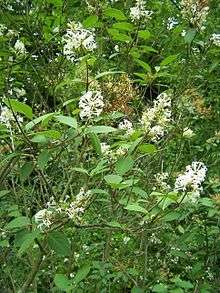Syringa emodi
| Syringa emodi | |
|---|---|
 | |
| Scientific classification | |
| Kingdom: | Plantae |
| (unranked): | Angiosperms |
| (unranked): | Eudicots |
| (unranked): | Asterids |
| Order: | Lamiales |
| Family: | Oleaceae |
| Genus: | Syringa |
| Species: | S. emodi |
| Binomial name | |
| Syringa emodi Wall. | |
Syringa emodi[1][2][3][4] is a species in the genus Syringa, in the family Oleaceae. It is also known as Himalayan lilac.[2][3]
Description
- Height/Spread: Shrub to 5m[2][3] in height, spreading to 4m.[3]
- Stems: Vigorous,[3] upright branches with robust branchlets[2] and stout shoots.[3] Bark is silver-grey and lenticellate.[2]
- Leaves: Leaves are elliptic-oblong,[2][3] measuring 9 cm[2] to 15 cm[3] in length and 5 cm in width, and are dark green and glabrous above and silvery-gray and slightly pubescent beneath when young.[2]
- Flowers: Unpleasantly scented,[3] purple,[2] pale lilac,[3] or white[2] flowers are borne on upright,[3] terminal[2] panicles to 15 cm long.[3] Tube measures 1 cm in length; lobes short, valvate, linear-oblong, and hooded at the tips. Anthers protrude about halfway.[2] Flowers in early summer,[3] from May–June.[2]
- Fruit: Fruits September to October.[2]
Habitat
Slopes at 2000-3000m altitude.[2]
Distribution
Afghanistan,[2][3][4] Pakistan, Western[2] Himalaya,[2][3][4] Kashmir (Ladakh), Nepal.[2]
Cultivation
Widely cultivated.[2][3] Notable cultivars include:[2]
- 'Aurea'
- 'Elegantissima'
- 'Variegata'
Etymology
Emodi is derived from the Sanskrit hima, meaning 'snow' (Sanskrit hima-alaya, identifies the Himalayas as the 'abode of snow'). Syringa is derived from the Greek word syrinx, meaning 'pipe' or 'tube'. Named for the use of its hollow stems to make flutes. In Greek mythology, the nymph Syringa was changed into a reed.[5]
References
- ↑ The Plant List http://www.theplantlist.org/tpl1.1/record/kew-356258
- 1 2 3 4 5 6 7 8 9 10 11 12 13 14 15 16 17 18 19 20 21 Fiala, John L. "Lilacs: a gardener's encyclopedia", 2nd ed. copyright Timber Press 2008. rev. and updated by Freek Vrugtman. First ed. published 1988, copyright Timber Press. ISBN 9780881927955. pp 106-107
- 1 2 3 4 5 6 7 8 9 10 11 12 13 14 15 16 Brickell, Christopher "The Royal Horticultural Society A-Z of Garden Plants (Volume 2: K-Z)", 3rd ed. Copyright 1996, 2003, 2008 Dorling Kindersley Ltd., London. ISBN 9781405332965. pp 1018
- 1 2 3 Mabberley, D. J., "Mabberley's Plant-Book", 3rd ed., Cambridge University Press, 2008. ISBN 9780521820714 (hardback) pp 836
- ↑ Gledhill, David (2008). "The Names of Plants". Cambridge University Press. ISBN 9780521866453 (hardback), ISBN 9780521685535 (paperback). pp 153, 369
This article is issued from Wikipedia - version of the 5/18/2016. The text is available under the Creative Commons Attribution/Share Alike but additional terms may apply for the media files.